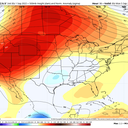Brutal heat dome envelops the West, bringing record-breaking temperatures

An intense, sprawling heat dome is causing the most intense, long-lasting heat wave of the summer in parts of the West.
The big picture: This heat wave will be a record-breaking event lasting into next week in California and surrounding states. It brings with it serious public health dangers, electric grid challenges and wildfire risks, officials warn.
- As of Thursday afternoon, about 46 million were under heat warnings, advisories and watches across a five-state region in the West.
In California, excessive heat warnings, the most urgent hot weather alert in the National Weather Service's (NWS) arsenal, are in effect from San Diego all the way north to Mount Shasta through at least Tuesday, and in some cases longer.
- High temperatures in downtown Los Angeles could hit 105°F on Sunday, the NWS is forecasting.
- City officials have opened cooling shelters for those without access to air conditioning.
- Inland areas will be even hotter, and ominously, nighttime lows across the state wave region are forecast to set records of their own, which will deprive people of the opportunity to cool down, raising the risk of heat-related illness.
By the numbers: The fertile Sacramento Valley region will bake through the weekend through midweek next week with highs at or above 105 to 110°F. The heat will make for unsafe conditions for outdoor labor.
- Overnight lows in these regions may not fall below 80°F from Labor Day weekend through the middle of next week, the NWS warned Wednesday evening.
- In the desert region of southern California, Death Valley, Calif., could make a run at its September high temperature record of 124°F, and possibly even reach 126°F, Friday through the weekend and into next week, the NWS predicts.
If Death Valley reaches the latter figure it would tie the hottest temperature recorded on Earth during the month of September.
- Extreme heat will also affect Arizona, Idaho, Nevada, Montana and Utah.
The heat is on! Temperatures will continue warming today into the #LaborDayWeekend, with hottest days Sunday - Tuesday. This heat will be very dangerous, so plan ahead for adequate cooling and hydration! #CAwx
— NWS Sacramento (@NWSSacramento) September 1, 2022
Forecast: https://t.co/WjKBsJmkq2 pic.twitter.com/Zv6VO4FNBL
Threat level: The NWS is using particularly strong language to describe the heat wave's severity in California. The forecast office in Sacramento, which saw its hottest August on record, is rating the heat risk level as "very high," its top category for the Sunday through Tuesday period.
- "The combination of hot daytime temps & warm overnight lows over several days will lead to very high risk of heat-related illness for all populations," the NWS Sacramento office tweeted. "Fans will not provide adequate cooling, so use Air Conditioning or seek A/C at a public location or local cooling shelter."
During hot and humid weather, your body's ability to cool itself is challenged in ways you may not expect. Stay #WeatherReady by learning the symptoms of excessive heat exposure and the appropriate responses.https://t.co/bElee9Sdda #CAwx pic.twitter.com/q9e0DjBOVR
— NWS Los Angeles (@NWSLosAngeles) August 31, 2022
- Extreme heat is typically the biggest weather-related killer in the U.S., killing an average of 700 people annually.
The intrigue: California ISO, which operates California's electricity grid, is sounding the alarm about potentially record-setting energy demand for the year during this extreme heat event. The electricity demand is expected to exceed this year's record of 48,000 megawatts on Monday, when the heat peaks.
- Cal ISO began issuing Flex Alerts on Wednesday and anticipates continuing to do so between 4 and 9 p.m. throughout the heat wave, since this is when electricity demand is highest.
- "The top three conservation actions are to set thermostats to 78 degrees or higher, avoid using large appliances and charging electric vehicles, and turn off unnecessary lights," California ISO stated.
- The mention of car charging a week after California passed regulations to stop selling gasoline-powered cars beyond 2035 stirred ridicule on social media Wednesday, particularly from skeptics of the state's policies.
What they're saying: Daniel Swain, a climate scientist at UCLA, said the heat wave will be a high-impact event due to its long duration of extremely hot days and unusually mild nights.
- "In some spots, this one checks all the boxes (except high humidity)," he told Axios via email. "Potentially record-breaking maximum temperatures, record-breaking minimum temperatures, long duration, widespread nature, and coincidence with [the] peak of fire season," Swain said.
Context: The heat will further intensify the California drought and raise wildfire risks.
- According to Climate Central's "Climate Shift Index," human-caused climate change has made the warm overnight low temperatures in the West, including California, five times more likely to occur than they would in the absence of added greenhouse gases.
- Climate science shows heat waves are becoming more frequent and intense worldwide due to human-caused global warming.